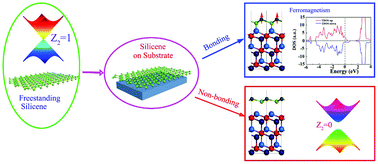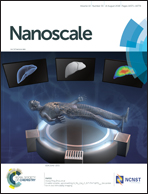Substrate-induced magnetism and topological phase transition in silicene†
Abstract
Silicene has shown great potential for applications as a versatile material in nanoelectronics and is particularly promising as a building block for spintronic applications. Unfortunately, despite its intriguing properties, such as a relatively large spin–orbit interaction, one of the greatest obstacles to the use of silicene as a host material in spintronics is its lack of magnetism or a topological phase transition owing to the silicene–substrate interaction, which influences its fundamental properties and has yet to be fully investigated. Here, we show that when silicene is grown on a CeO2 substrate, an appreciable robust magnetic moment appears in silicene covalently bonded to CeO2 (111), while a topological phase transition from a topological insulator to a band insulator occurs regardless of van der Waals (vdW) interactions or covalent bonding interactions at the interface. The induced magnetism of silicene is due to the breaking of Si–Si π-bonds, which also results in a trivial topological phase. The silicene–substrate interaction, and even weak vdW forces (equivalent to an electric field), can destroy the quantum spin Hall effect (QSHE) in silicene. We propose a viable strategy—the construction of an inverse symmetrical sandwich structure (protective layer/silicene/substrate)—to preserve the quantum spin Hall (QSH) state of silicene in a system with weak vdW interactions. This work takes a critical step towards the fundamental physics and realistic applications of silicene-based spintronic devices.



 Please wait while we load your content...
Please wait while we load your content...